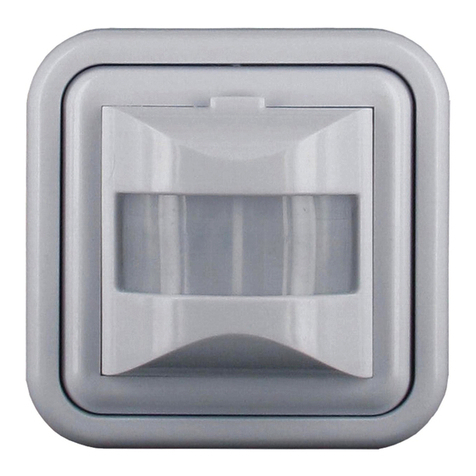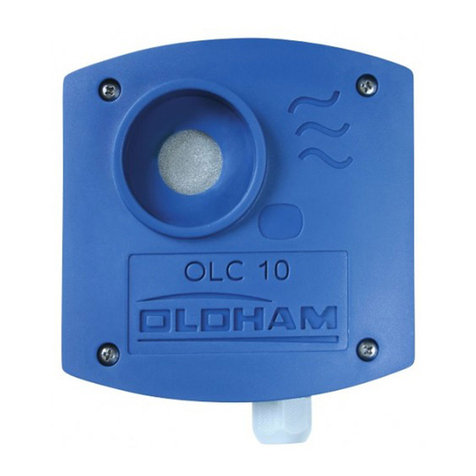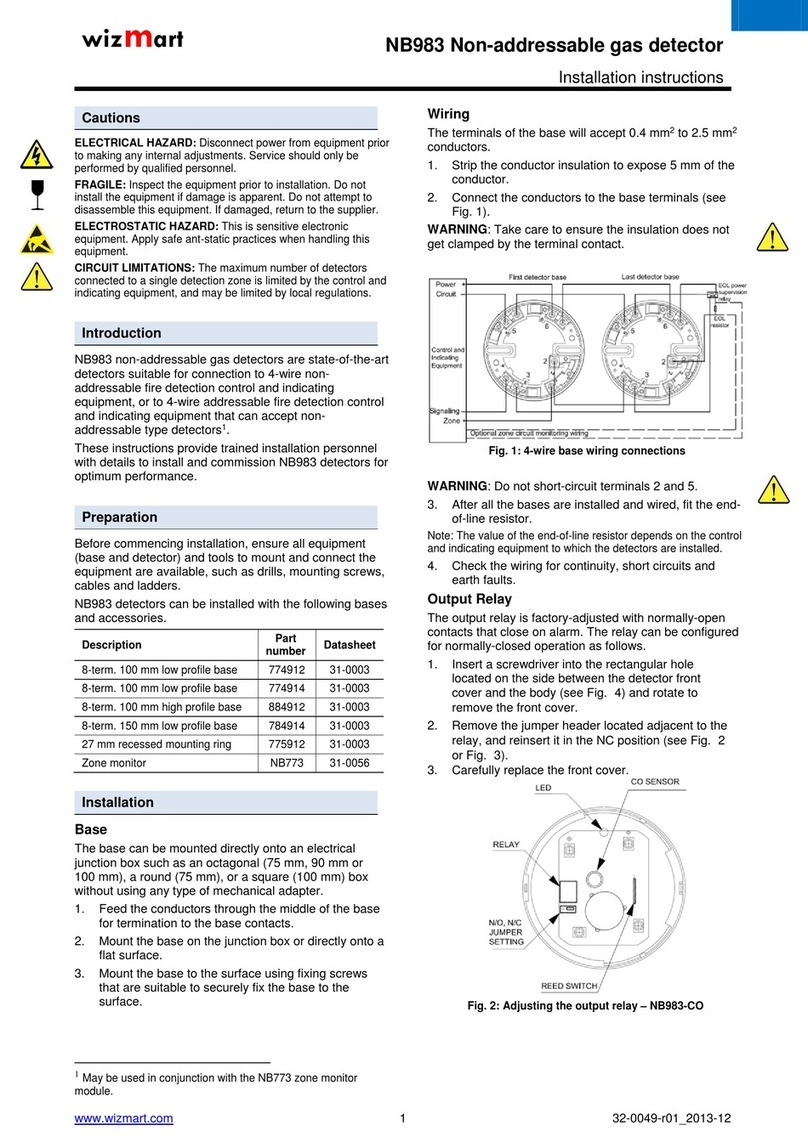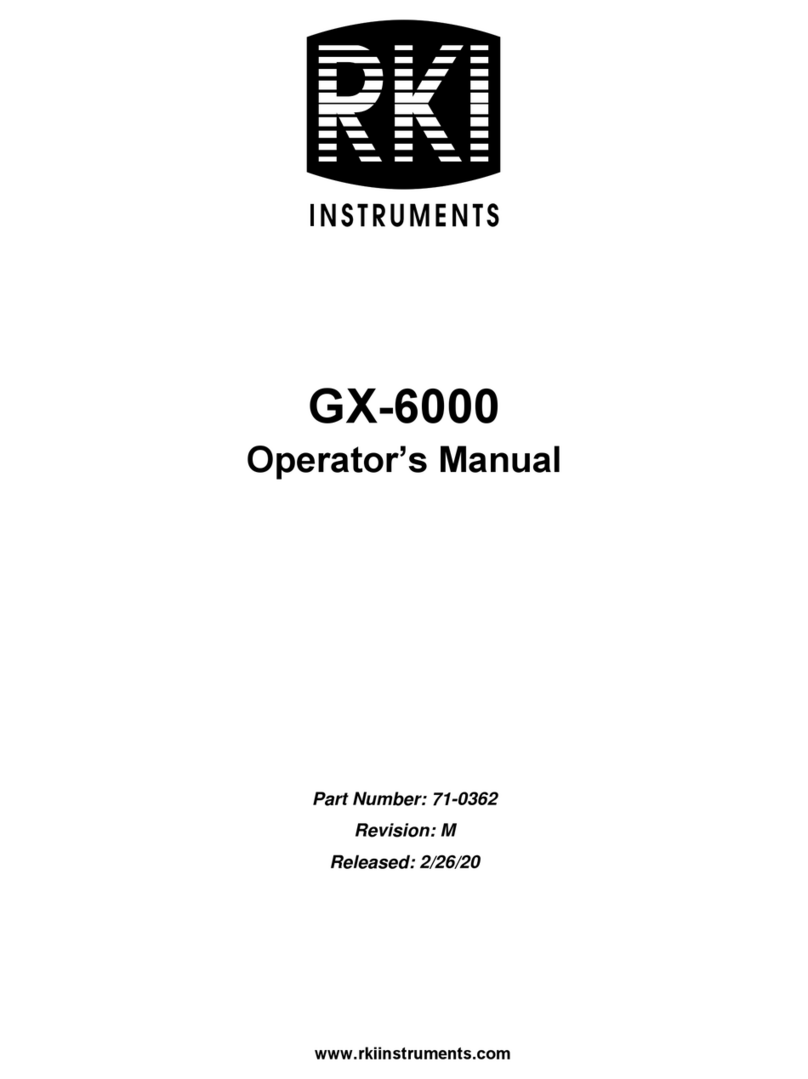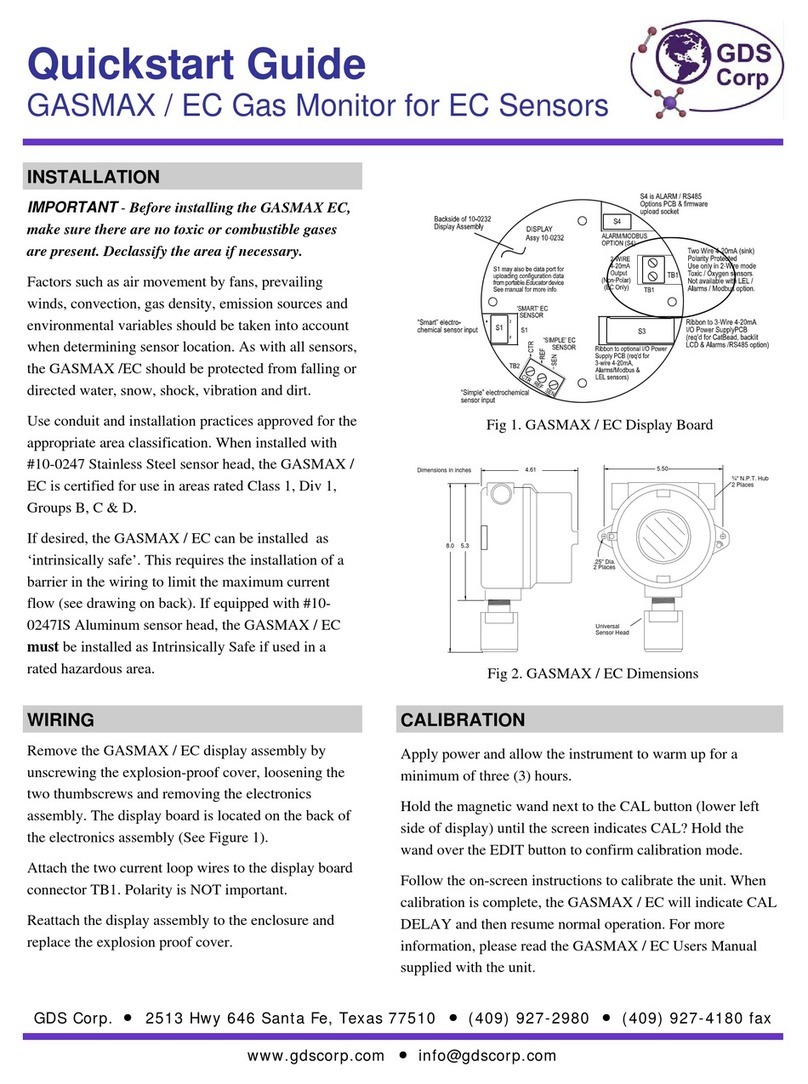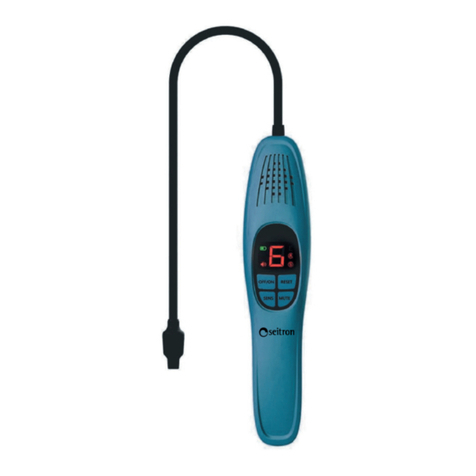EN - Gas Detector
Congratulaons with the purchase of this ELRO gas detector!
Read these instrucons carefully and store them in a safe
place for future usage. This product is intended to detect the
leakage of natural gas (methane) and should be used in
domesc premises. as well as mobile homes.
WARNINGS
* The following substances can affect the sensor and may
cause false alarms: Silicone vapors, hydrogen sulfide, sulfur
oxides, chlorine gas, hydrogen chloride, alkaline metals,
water, alcohol based products, propane, isobutene,
isopropanol, ethylene, benzene, toluene, ethyl acetate,
paints, thinner, solvents, adhesives, hair sprays, aer
shaves, perfumes and some cleaning agents etc.
* Risk of electric shock when the apparatus is tampered with
* To prevent injury, this apparatus must be securely aached
to the floor/wall in accordance with the installaon
instrucons.
* Apparatus should be installed by a competent person.
* Most people are able to smell gas at concentraons below
the alarm level. This does not necessarily indicate a failure
of the device!
* Always make sure that your gas installaon complies with
the naonal regulaons.
Product overview
a Power indicator
b Fault indicator
c Alarm indicator
d Test/Silence buon
e Alarm sounder
Locate your device
The most likely origin for an escape of gas in domesc
premises is from gas appliances (such as gas cookers)
themselves, the connecons between them and the fixed gas
distribuon system in buildings.
Where to install an detector?
* Ideally in every room containing a gas appliance. If this is
not possible, install the detector in the room where gas
escape is most likely to occur (usually the kitchen)
* Natural gas is lighter than air, so install the device above
the level of a possible gas to escape and near the ceiling
(< 0,3m from the ceiling)
* On a place where the buons on the detectors are
easy to press
Where not to install an detector?
* Where air movement is impended by furniture and
furnishings
* In an enclosed space (in a cupboard/behind a curtain)
* Directly above a sink
* Next to a door/window
* Next to an extractor fan
* In any outside locaon
* In an area where the temperature may drop below -10°C
or exceed 40 °C.
* Where dirt and dust may block the sensor
* In a damp or humid locaon
* Immediately above or next to gas appliances to prevent
unwanted alarms
Mount & acvate the alarm
1 Drill two holes in the wall of 5 mm and insert the
plasc plugs
2 Aach the bracket to the plugs and fix the screws
to the plugs
3 Place the alarm on the bracket and pull it down.
4 Insert the plug into the socket
If the acvaon was successful, the green LED will light up
and the detector will enter the self-detecon mode for about
3 minutes. Aer three minutes it will turn into normal
operaon mode, indicated by the green LED being constantly
on. Aer this, test the alarm by using the test buon.
Alarm silence mode
Before mung an alarm, always make sure the alarm the
alarm is false. In case of doubt, take the necessary acon! To
mute the alarm, press the test buon. The alarm will pause
for 5 minutes while the alarm indicator keeps flashing.
What to do if natural gas is detected?
If the gas detector gives alarm, please take the
following acons:
* Keep calm and exnguish all naked flames, including all
smoking material
* Turn off all gas appliances
* Do not switch on or off any electrical equipment, including
the gas detecon apparatus
* Turn off the gas supply at the gas main control and/or (with
a LPG supply) the storage tank
* Open doors and windows to increase venlaon
* Do not use a telephone in the building where the
presence of gas is suspected.
If the alarm connues to operate and the cause of the leak is
not apparent and/or cannot be corrected, leave the premises
immediately. Nofy your local gas supplier/gas emergency
service to control and if necessary repair your devices.
Maintenance
Test your gas detector every month by pressing the test
buon for 1 seconds. If the device funcons properly, the red
LED-light will flash 0.5s and it will beep simultaneously. If you
do not hear a beep or see a light aer the test, the device is
not funconing correctly and should be replaced as soon as
possible!
Warning
Other test methods such as gas lighters, flammable vapours
etc. may cause false conclusions!
* Clean your device once a month: Remove the device from
the wall and dust it with a so brush or cloth. Aer
cleaning, always test device by pressing the test buon.
Specificaons
Power source : 220-240VAC / 50-60Hz
Sensor type : Semiconductor
Power consumpon : ≤ 4W
Detects gas types : Natural Gas (Methane)
Gas volume rao : 6% LEL (Lower Explosive Limit)
Apparatus type : Type B
Sound level : 85 dB (A) at 1 meter
Product lifeme : 5 years
Protecon level : IPX2D
Operaon Ambient Condion:
-10°C ~ +40°C, 0 ~ 95% non-condensing
Storage/Transport Ambient Condion:
-20°C ~ +50°C, 0 ~ 95% non-condensing
Symbols
Recycling and disposal: The WEEE symbol (a) means that this
product and baeries must be disposed separately from
other household waste. When it reaches its end of life, take it
to a designated waste collecon point in your area to
guarantee a safe disposal or recycling. Protect the
environment, human health and natural resources! Read the
manual (b) before use and store it in a safe place for future
use and maintenance. Download (c) Declaraon of
Performance (DoP) at www.elro.eu.
(a) (b) Download
(c) (a) (b) Download
(c)
Operaon Mode LED Beep Required acon
Normal operaon Green: Constantly on No beep No acon
Fault warning Yellow: 1x every 30 sec 1x every 30 sec Device is not funconing correctly
Replace device!
End of life warning Yellow: 3x every 30 sec 3x every 30 sec Replace device!
Alarm (Gas detected) Red: 0.5s ON, 0.5s OFF Loud alarm: 0.5s ON, 0.5s OFF What to do if natural gas is detected?
Alarm silence mode Red: 0.5s ON, 0.5s OFF No beep Stay alert!
Test mode Red: 0.5s ON, 0.5s OFF 0.5s ON, 0.5s OFF See: Maintenance
Modus LED Piepton Erforderliche Reakon
Normal Betrieb Grün: Konstant an Kein Piepen Keine Reakon erforderlich
Fehlerwarnung Gelb: 1x jede 30 sek 1x jede 30 sek Gerät funkoniert nicht richg.
Gerät ersetzen!
Ende der Lebensdauer Gelb: 3x jede 30 sek 3x jede 30 sec Gerät ersetzen!
Alarm (Gas detekert) Rot: 0.5s ON, 0.5s OFF Laut 0.5s ON, 0.5s OFF Was machen wenn Erdgas detekert wird?
Alarm stumm geschaltet Rot: 0.5s ON, 0.5s OFF Kein Piepen Bleibe wachsam!!
Testmodus Rot: 0.5s ON, 0.5s OFF 0.5s ON, 0.5s OFF Siehe: Wartung
DE - Gasmelder
Glückwunsch zum Kauf ihres einsteckbaren ELRO
Gasdetektors! Lesen Sie diese Bedienungsanleitung sorgfälg
und heben Sie sie auf einem sicheren Platz für später auf.
Dieses Produkt ist dazu gedacht um Erdgas-Lecks (Methan) zu
erkennen und sollte in Häusern und Wohnmobilen benutzt
werden.
Warnungen:
* Die folgenden Substanzen können den Detektor
beeinflussen und ihn fälschlicherweise auslösen:
Silikondämpfe, Schwefelwasserstoff, Schwefeloxide,
Chlorgas, Chlorwasserstoff, alkalische Metalle, Wasser,
alkoholische Produkte, Propan, Isobutan, Isopropanol,
Ethylen, Benzol, Toluol, Ethylacetat, Farben, Verdünner,
Lösungsmiel, Klebstoffe, Haarsprays, Rasierwasser,
Parfums und verschiedene Reinigungsmiel.
* Risiko eines elektrischen Schocks besteht, wenn Sie das
Gerät modifizieren.
* Um Verletzungen zu vermeiden, befesgen Sie diesen
Apparat sicher an der Decke/Mauer. Beachten Sie dafür
bie dieses Benutzerhandbuch.
* Der Apparat sollte von einer kompetenten Person
angebracht werden.
* Die meisten Leute können Gas in Konzentraonen riechen
die unter dem Alarmlevel liegen. Dies deutet nicht
automasch auf einen Fehler des Geräts hin.
* Gehen Sie immer sicher, dass ihre Gasinstallaon mit den
naonalen Besmmungen übereinsmmen.
Produktübersicht
a. Stromanzeige
b. Fehleranzeige
c. Alarmanzeige
d. Test/Stumm Knopf
e. Alarmgeber
Ihren Apparat an der richgen Stelle anbringen
Die wahrscheinlichsten Quellen für ein Gasleck in
Wohnhäusern sind Gasgeräte (wie z.B. Gasherd) selbst, die
Verbindungen zu ihnen und fest installierte Gasverteilungs-
Systeme in Gebäuden.
Wo man das Gerät anbringen soll?
* Idealerweise: in jedem Raum das ein Gasgerät enthält.
Wenn nicht möglich, installieren Sie einen Detektor in dem
Raum in dem ein Leck am wahrscheinlichsten ist
(üblicherweise die Küche)
* Erdgas ist leichter als Lu, installieren Sie den Melder also
über einer möglichen Gasquelle und nahe an der Decke
(<0,3m von der Decke enernt)
* An einer Stelle an der die Knöpfe gut erreichbar sind
Wo soll man das Gerät nicht anbringen?
* Wo die Luströmung durch Möbel beeinflusst wird
* In einem geschlossenen Raum (in einem Schrank/hinter
einem Vorhang)
* Direkt über einem Waschbecken
* Neben einer/m Tür/Fenster
* Neben einer Abzugshaube
* An Stellen an der die Temperatur <-10 und >40 grad
erreichen kann
* An Plätzen an den Dreck/Staub den Melder blockieren
können
* An einer dunsgen/feuchten Stelle
* In direkter Umgebung eines Gasgerätes um Fehlalarme
zu verhindern
Den Alarm moneren und akvieren
1. Bohren Sie zwei 5mm Löcher in die Wand und fügen Sie die
Dübel ein. Die Distanz zwischen den 2 Löchern muss 30mm
betragen.
2. Befesgen Sie die Klammer an den Dübeln und drehen Sie
die Schrauben ein.
3. Platzieren Sie den Alarm auf der Klammer und ziehen Sie
ihn runter.
4. Stecken Sie den Stecker in die Steckdose.
Wenn die Akvaon erfolgreich war, leuchtet die grüne LED
und der Detektor begibt sich für ungefähr 3 Minuten in den
Selbstdetekons-Modus. Nach 3 Minuten schaltet er sich in
den normalen Betriebsmodus, was durch das konstant
eingeschaltete grüne Licht angezeigt wird. Testen Sie danach
den Alarm indem Sie den Testknopf drücken.
Alarm stumm Schalten
Bevor Sie den Alarm stumm schalten, gehen Sie sicher, dass
es sich um einen falschen Alarm handelt. Wenn Sie Zweifel
haben, reagieren Sie bie wie es erfordert wird! Um den
Alarm auf stumm zu schalten, drücken Sie den Testknopf. Der
Alarm pausiert für 5 Minuten, während die Alarmanzeige
weiter blinkt.
Was machen wenn Erdgas detekert wird?
Wenn der Gasdetektor einen Alarm auslöst, nehmen Sie bie
folgende Maßnahmen:
* Bleiben Sie ruhig und löschen Sie alle offenen Flammen
inklusive rauchendes Material
* Schalten Sie die Gasgeräte aus
* Schalten Sie kein elektrisches Gerät an oder aus, inklusive
dem Gasdetektor
* Schalten Sie die Gaszufuhr am Hauptverteiler ab und/oder
(mit LPG zufuhr) den Lagertank
* Öffnen Sie Türen und Fenster und erhöhen Sie die Lüung
* Benutzen Sie kein Telefon in dem Gebäude in dem sich
möglicherweise Gas befindet.
Wenn der Alarm nicht auört und die Quelle des Lecks nicht
offensichtlich ist und/oder das Leck nicht behoben werden
kann, verlassen Sie das Gebäude sofort. Benachrichgen Sie
ihren lokalen Gaslieferanten/Gasnoallservice zur Kontrolle
und, wenn nög, Reparatur ihrer Geräte.
Wartung
Testen Sie ihren Gasdetektor ein Mal pro Monat indem Sie
den Testknopf für 0.2 Sekunden drücken. Wenn das Gerät
richg funkoniert, blinkt die rote LED 4-mal und wird von
einem Piepen begleitet. Wenn Sie kein Licht sehen und kein
Piepen hören funkoniert das Gerät nicht mehr richg und es
sollte somit so schnell wie möglich ersetzt werden!
Warnung
Andere Testmethoden so wie Gasfeuerzeuge, enlammbare
Dämpfe, etc. können falsche Resultate hervorbringen!
* Säubern Sie ihr Gerät ein Mal im Monat: enernen Sie das
Gerät von der Mauer und stauben Sie es mit einer weichen
Bürste oder einem Tuch ab. Nach dem säubern, testen Sie
das Gerät indem Sie den Testknopf drücken.
Spezifikaonen:
Stromquelle : 220-240VAC / 50-60Hz
Sensortyp : Halbleiter
Stromverbrauch : ≤4 W
Detekerte Gastypen : Erdgas (Methan)
Gasmengenverhältnis : 6% UEG (Untere Explosionsgrenze)
Apparatetyp : Typ B
Lautstärke : 85dB(A) auf 1 Meter Enernung
Betriebstemperatur : -10°C ~ 40°C
Produkt-Lebensdauer : 5 Jahre
Betriebsfeuchgkeit : 0 ~ 95% RH
Schutzlevel : IPX2D
Operaonstemperatur
-10°C~+40°C, 30~95% nicht kondensierend
Lager/Transport Temperatur
-20°C~+50°C, 10~95% nicht kondensierend
Symbols
Recycling und Entsorgung: Das WEEE-Symbol (a) bedeutet,
dass dies Produkt und seine Baerien separat von anderem
Haushaltsmüll entsorgt werden muss. Wenn das Ende der
Produktlebensdauer erreicht ist, bringen Sie das Produkt zur
kommunalen Sammelstelle um eine sichere Entsorgung oder
Recycling zu gewährleisten. Schützen Sie Umwelt und
menschlichen Gesundheit und gehen Sie verantwortlich mit
natürlichen Ressourcen um! Lesen Sie vor Gebrauch die
beiliegende Bedienungs-anleitung (b) und heben Sie diese
auf, um eine sichere Nutzung und Wartung zu gewährleisten.
(c) Leistungserklärung (DoP) finden Sie auf www.elro.eu.
Home is not a place, it’s a feeling
EU - QUALITY
FG400011P
Manufacturer:
SITERWELL (ISO Cerfied)
No. 76 Haichuan Road, Chuangye
Zone B, Jiangbei, Ningbo, China
Importer:
ELRO Europe | www.elro.eu
Postbus 9607 - Box E800
1006 GC Amsterdam The Netherlands
Type B apparatus
EN50194-1:2009
EN Instrucon manual
DE Bedienungsanleitung
NL Gebruiksaanwzijzing
FR Manuel d'ulisaon
Minimum
Extra
Entree
Mount the alarm - Wall
Moneren den Alarm - Mauer
Montage alarm - Muur
Montage d'alarme - Mur
Wall - Mauer - Muur - MurWall - Mauer - Muur - MurWall - Mauer - Muur - Mur
150 cm
(NG Natural Gaz)
Ceiling - Decke - PlafondCeiling - Decke - PlafondCeiling - Decke - Plafond
Product overview / Produktübersicht
Productoverzicht / Aperçu du produit
POWER FAULT ALARM
Natural GAS Detector
FG400011P
TEST / HUSH
MAXIMUM LIFETIME
5 YEARS AFTER ACTIVATION
abc
d
e
min. 30 cm
145 cm
Cable
Kabel
Câble
Power Source:
220-240VAC
50-60Hz






